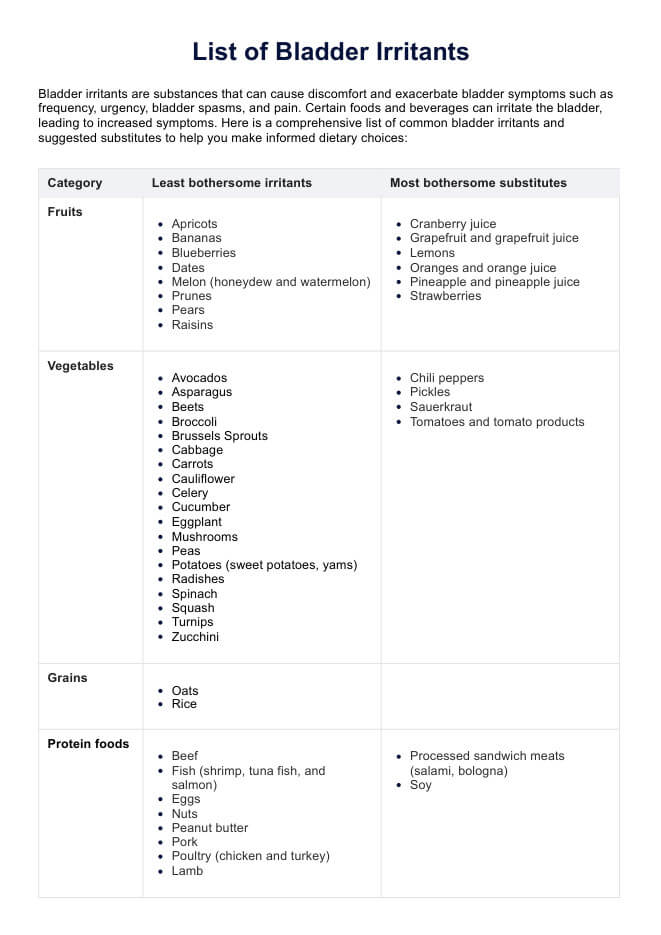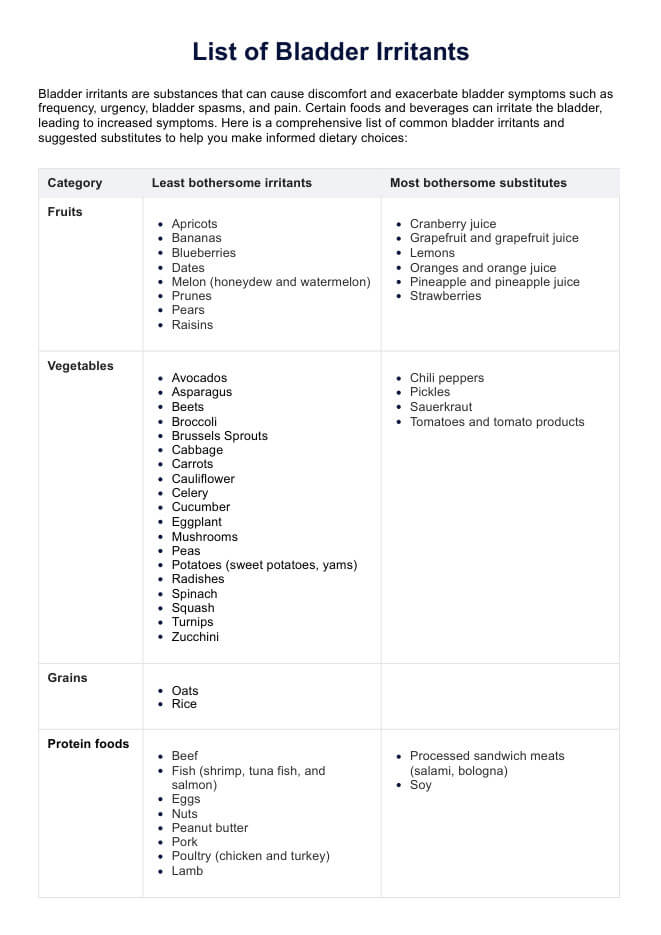List of Bladder Irritants
Discover a comprehensive guide to bladder irritants, their impact, and substitutes. Learn how to use our template and improve patient care with Carepatron.


What are bladder irritants?
Bladder irritants are substances that can cause discomfort and exacerbate symptoms related to bladder health. These irritants are typically found in certain foods, drinks, and medications, and they can lead to increased frequency of urination, urgency, bladder spasms, and pain. Identifying and avoiding these irritants can be crucial for individuals who experience bladder sensitivity or conditions such as interstitial cystitis and overactive bladder.
Bladder irritating foods examples
Several common bladder irritants include:
- Caffeine: Found in coffee, tea, cola drinks, and energy drinks, caffeine can increase bladder activity and lead to urgency and frequency.
- Alcohol: All types of alcohol can irritate the bladder, leading to increased urination and discomfort.
- Artificial sweeteners: Substances such as aspartame, saccharin, and sucralose can cause bladder irritation.
- Acidic foods: Citrus fruits and juices, such as oranges, lemons, limes, grapefruits, tomatoes, and cranberries, are highly acidic and can irritate the bladder lining.
- Carbonated beverages: Sodas, sparkling water, and champagne contain substances that can irritate a sensitive bladder, potentially aggravating symptoms of overactive bladder (OAB).
- Spicy foods: Foods containing strong spices, such as chili peppers and curry, can cause bladder discomfort.
- Tomato-based products: Tomatoes and products such as ketchup, tomato sauce, and salsa are acidic and can irritate the bladder.
What can happen if the bladder becomes too irritated?
If the bladder becomes too irritated, it can lead to several uncomfortable and disruptive symptoms, including urinary frequency and overactive bladder symptoms. Bladder irritation can also lead to urinary incontinence, causing leakage and a loss of bladder control.
Initially, individuals may experience increased frequency and urgency of urination, feeling the need to use the bathroom more often and with greater urgency. This can interfere with daily activities and sleep, leading to frustration and decreased quality of life. In some cases, bladder spasms may occur, causing sudden, intense urges to urinate and sometimes resulting in involuntary leakage or incontinence.
As bladder irritation persists, the discomfort can escalate to chronic bladder pain. This pain can be constant or intermittent, significantly impacting an individual’s well-being and ability to perform everyday tasks. Chronic bladder pain is often associated with conditions like interstitial cystitis, a painful bladder syndrome characterized by persistent discomfort and frequent urination (Lim & O’Rourke, 2021). The constant irritation and inflammation can also increase the risk of urinary tract infections (UTIs), which can cause additional pain, burning, and other urinary symptoms.
In severe cases, prolonged bladder irritation can lead to various forms of incontinence, including stress incontinence and urge incontinence, making it difficult for individuals to control their urine flow. This can lead to embarrassment and social isolation.
List of Bladder Irritants Template
List of Bladder Irritants Sample
How to use our List of Bladder Irritants template
Our List of Bladder Irritants template is designed to help healthcare professionals guide their patients in managing bladder health more effectively. This comprehensive resource identifies common bladder irritants and provides suitable substitutes, making it easier for patients to adjust their diets and lifestyles.
Step 1: Download the template
Begin by downloading the List of Bladder Irritants template from our website. Ensure you have the latest version to benefit from any updates or improvements made to the document.
Step 2: Educate yourself
Familiarize yourself with the content of the template. Understanding the various bladder irritants and their substitutes will enable you to explain and discuss them effectively with your patients.
Step 3: Assess patient needs
During your consultation, assess the patient’s symptoms and dietary habits. Identify any potential bladder irritants in their current diet or medication regimen, including foods and drinks such as high-acid foods, caffeine, artificial sweeteners, and alcohol, that may contribute to their symptoms.
Step 4: Provide the template
Give the patient a copy of the List of Bladder Irritants template. Discuss the importance of avoiding these irritants and how making dietary changes can help alleviate their symptoms. Offer personalized advice based on their specific condition and dietary habits.
Step 5: Follow up
Schedule a follow-up appointment to review the patient’s progress. During this visit, discuss any changes in their symptoms and adjust their dietary plan as needed. Encourage the patient to keep track of any foods or drinks that seem to worsen their symptoms, using the template as a guide.
Benefits of this list for urologists and other healthcare professionals
Having a comprehensive List of Bladder Irritants is invaluable for urologists and other healthcare professionals. It aids in effectively managing patients’ bladder health by providing clear guidelines on what to avoid and suitable alternatives. Here are the top three benefits:
Enhanced patient education
The list serves as an excellent educational tool, helping patients understand the impact of their diet on bladder health. By providing this information, healthcare professionals can empower patients to make informed dietary choices that alleviate their symptoms.
Improved patient outcomes in managing urinary incontinence
With a clear understanding of bladder irritants and their substitutes, patients are more likely to adhere to dietary recommendations. This adherence can significantly improve bladder symptoms, enhancing overall patient outcomes and satisfaction.
Streamlined consultations
Having a ready-to-use template saves time during consultations. Healthcare professionals can quickly provide patients with a comprehensive list, allowing for more focused discussions on individual dietary adjustments and management strategies.
Reference
Lim, Y., & O’Rourke, S. (2021, April 20). Interstitial cystitis. National Institutes of Health; StatPearls Publishing. https://www.ncbi.nlm.nih.gov/books/NBK570588/
Commonly asked questions
Bladder irritants are substances that can cause discomfort and exacerbate bladder symptoms such as frequency, urgency, bladder spasms, and pain. They are commonly found in certain foods, drinks, and medications. For example, acidic foods like citrus fruits, tomatoes, and cranberries can irritate the bladder and worsen symptoms of overactive bladder (OAB) and urge incontinence.
Start by eliminating the most common bladder irritants from your diet for at least two weeks. Gradually reintroduce each item one at a time to identify specific irritants. Keep a diary to track your symptoms and any changes.
Yes, there are many safe substitutes for common bladder irritants. For example, herbal tea can replace caffeinated beverages, and mild cheeses can replace aged cheeses. The List of Bladder Irritants provides many such alternatives to help you adjust your diet.







































































































